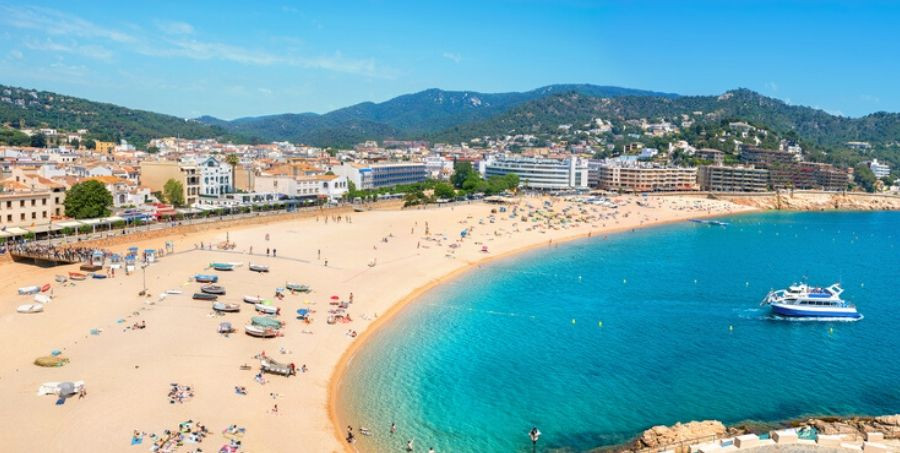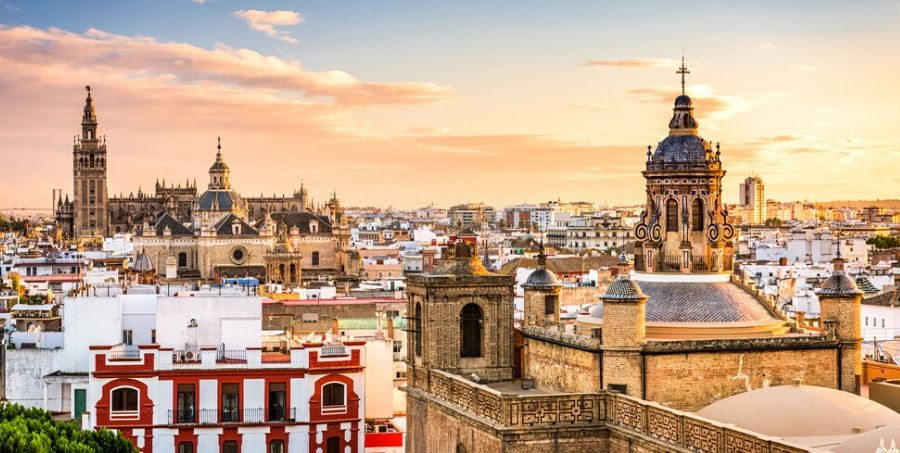Why Travel To Spain? Spain is a vibrant and diverse country offering a rich tapestry of culture, history, stunning landscapes, and delicious cuisine, making it a must-visit destination for travelers worldwide, and SIXT.VN is here to guide you through it all. Whether you’re seeking sun-kissed beaches, historical cities, or delectable food, Spain has something for everyone, offering unforgettable experiences. Consider SIXT.VN your premier travel partner for Spanish exploration, offering expert advice and convenient services.
1. Is Spain Worth Visiting For Its Stunning Landscapes?
Yes, Spain is absolutely worth visiting for its stunning landscapes. From the majestic Pyrenees Mountains to the sun-drenched shores of the Costa Brava, Spain’s diverse geography offers breathtaking vistas and unforgettable outdoor adventures. According to research from the World Tourism Organization, in 2023, Spain was ranked as one of the top tourist destinations in the world, drawing visitors in with its natural beauty.
Spain’s diverse landscapes are a major draw for tourists. The country boasts everything from snow-capped mountains perfect for skiing to arid deserts that feel like another planet. Here are some notable regions:
- Pyrenees Mountains: These mountains form a natural border with France and offer incredible hiking, skiing, and picturesque villages.
- Andalusia: Known for its rolling hills, olive groves, and stunning coastline, Andalusia captures the essence of southern Spain.
- Canary Islands: This volcanic archipelago offers unique landscapes, including black sand beaches and the towering Mount Teide on Tenerife.
- Galicia: Located in the northwest, Galicia features lush green landscapes and rugged coastlines, resembling Ireland or Scotland more than typical Spanish scenery.
 experience-mount-teide-in-tenerife.jpg
experience-mount-teide-in-tenerife.jpg
Exploring Tenerife’s Volcanic Views: A visit to Tenerife offers you the chance to witness some of Spain’s most dramatic volcanic landscapes. As the largest of the Canary Islands, Tenerife features the imposing Mount Teide, the third-largest volcanic structure in the world. Whether you hike to the summit or take the cable car, the panoramic views are simply awe-inspiring. According to the Canary Islands Tourism Board, Mount Teide National Park is one of the most visited national parks in Spain, attracting millions of visitors each year.
2. What Makes Spain’s Beaches A Must-See Destination?
Spain’s beaches are a must-see destination because it boasts over 5,000 miles of coastline and thousands of beaches, many of which have been awarded Blue Flag status for their cleanliness and environmental standards, making them perfect for relaxation and water sports. Data from the Spanish Tourism Institute shows that coastal tourism accounts for a significant portion of Spain’s annual revenue, emphasizing the importance of its beaches to the national economy.
Spain’s extensive coastline offers a beach for every type of traveler. Here’s why they’re so appealing:
- Variety: From the rugged shores of the Costa Brava to the sandy stretches of the Costa de la Luz, Spain’s beaches are incredibly diverse.
- Climate: With over 300 days of sunshine each year, Spain offers an ideal climate for beachgoers.
- Blue Flag Beaches: Spain consistently ranks high in the number of Blue Flag beaches, indicating excellent water quality, safety, and environmental management.
- Accessibility: Whether you’re looking for a secluded cove or a bustling resort beach, Spain has options to suit every preference and accessibility need.
 experience-the-costa-brava-on-holiday-in-spain.jpg
experience-the-costa-brava-on-holiday-in-spain.jpg
Discovering the Unspoiled Beaches of Costa de la Luz: A holiday to Costa de la Luz introduces you to some of Spain’s best-kept beach secrets. Located in Andalusia near the Portuguese border, this region is famed for its pristine beaches, unspoiled coves, and crystal-clear waters. Unlike some of the more crowded tourist spots, Costa de la Luz offers a tranquil escape where you can truly unwind and soak up the sun. Tourism research highlights that Costa de la Luz is increasingly popular among those seeking a more authentic and relaxed beach experience.
3. Why Is Spanish Food A Major Draw For Tourists?
Spanish food is a major draw for tourists because of its rich flavors, diverse regional specialties, and the social experience of sharing tapas, offering a culinary adventure that tantalizes the taste buds and creates lasting memories. According to a study by the Spanish Ministry of Agriculture, Fisheries and Food, gastronomy is a primary motivator for many tourists visiting Spain, with many seeking out authentic culinary experiences.
Spanish cuisine is celebrated worldwide for its unique flavors and social dining culture. Here’s what makes it so appealing:
- Regional Diversity: Each region of Spain offers its own unique dishes, from paella in Valencia to tapas in Andalusia.
- Tapas Culture: The tradition of sharing small plates of food (tapas) is a social and enjoyable way to sample a variety of flavors.
- Fresh Ingredients: Spain’s cuisine emphasizes fresh, locally sourced ingredients, including seafood, olive oil, and seasonal vegetables.
- Michelin-Starred Restaurants: Spain is home to numerous Michelin-starred restaurants, showcasing innovative and high-quality gastronomy.
 enjoy-taps-on-holiday-in-spain.jpg
enjoy-taps-on-holiday-in-spain.jpg
Enjoying Tapas in Costa Brava: A holiday to Costa Brava offers you a deep dive into Spanish culinary traditions, particularly the experience of enjoying authentic tapas in Barcelona. Tapas, believed to have originated in Spain, are small, savory dishes that are perfect for sharing. In Barcelona, you’ll find countless tapas bars serving everything from chorizo sausage to patatas bravas. Eating your way through these local eateries is a fantastic way to immerse yourself in the local culture. Culinary experts note that the tapas scene in Barcelona is one of the most vibrant in the world, attracting food lovers from all corners of the globe.
4. What Attracts Visitors To Spain’s Cosmopolitan Cities?
Visitors are attracted to Spain’s cosmopolitan cities because they offer a rich blend of history, culture, art, and modern amenities, providing a diverse and exciting urban experience. Data from the Institute for Tourism Studies indicates that urban tourism is on the rise in Spain, with cities like Madrid, Barcelona, and Seville being among the most visited destinations.
Spain’s cities are vibrant hubs of culture, history, and modern life. Here’s what makes them so appealing:
- Historical Significance: Cities like Seville and Salamanca boast UNESCO World Heritage sites and well-preserved historical centers.
- Art and Culture: Madrid and Barcelona are renowned for their world-class museums, art galleries, and vibrant arts scenes.
- Architecture: From the Gothic Quarter in Barcelona to the Royal Palace in Madrid, Spanish cities showcase a stunning array of architectural styles.
- Shopping and Dining: Spain’s cities offer a wide range of shopping options, from high-end boutiques to local markets, as well as diverse culinary experiences.
 visit-seville-on-guided-spain-holiday.jpg
visit-seville-on-guided-spain-holiday.jpg
Discovering the Historical Charm of Salamanca: Visiting the historical city of Salamanca introduces you to a UNESCO World Heritage Site brimming with cultural richness. As you stroll through its pedestrianized city center, you’ll discover a vibrant atmosphere with lively cafés, terraces, and bars. Salamanca’s ancient buildings and rich history make it an unforgettable destination. According to UNESCO, Salamanca’s historic center is a prime example of a Renaissance city, attracting historians and tourists alike.
5. Why Should Travelers Explore Spain’s Vibrant Villages?
Travelers should explore Spain’s vibrant villages because they offer a glimpse into authentic Spanish culture, showcasing charming architecture, local traditions, and breathtaking scenery, providing a unique and memorable travel experience. Research from rural tourism organizations in Spain indicates that these villages are becoming increasingly popular among tourists seeking a more authentic and off-the-beaten-path experience.
Spain’s villages are hidden gems that offer a unique glimpse into the country’s cultural heritage. Here’s why they’re worth exploring:
- Authentic Culture: These villages offer a chance to experience traditional Spanish life, away from the hustle and bustle of the cities.
- Charming Architecture: Whitewashed houses, cobbled streets, and historic churches create a picturesque and charming atmosphere.
- Local Traditions: Many villages maintain unique traditions and festivals that have been passed down through generations.
- Beautiful Scenery: Nestled in rolling hills or along rugged coastlines, these villages often offer breathtaking views and access to natural beauty.
 visit-frigiliana-on-guided-spain-holiday.jpg
visit-frigiliana-on-guided-spain-holiday.jpg
Exploring the Beauty of Frigiliana: A visit to Frigiliana, often hailed as one of Spain’s prettiest villages, offers you an authentic taste of Andalusian charm. Located near Nerja, Frigiliana is known for its cobbled streets, whitewashed houses, and vibrant arts and crafts scene. Here, you can indulge in local delicacies like fig bread and sugarcane honey while soaking up the village’s unique atmosphere. Travel guides often highlight Frigiliana as a must-visit destination for those seeking an authentic and picturesque Spanish experience.
6. How Does Spain Cater To Different Types Of Travelers?
Spain caters to different types of travelers by offering a wide range of activities and attractions, from cultural tours and historical sites to outdoor adventures and culinary experiences, ensuring that everyone finds something to enjoy. According to the Spanish Tourist Board, Spain is one of the most versatile travel destinations globally, offering options for cultural enthusiasts, adventure seekers, and relaxation enthusiasts alike.
Spain’s diversity makes it an ideal destination for all types of travelers. Here’s how it caters to different interests:
- Cultural Enthusiasts: With its rich history, art, and architecture, Spain offers a wealth of cultural experiences, including visits to museums, historical sites, and flamenco shows.
- Adventure Seekers: From hiking in the Pyrenees to surfing on the Atlantic coast, Spain provides ample opportunities for outdoor adventures.
- Foodies: With its diverse regional cuisine and vibrant tapas culture, Spain is a paradise for food lovers.
- Relaxation Seekers: Spain’s beautiful beaches, spas, and tranquil countryside offer the perfect setting for relaxation and rejuvenation.
7. What Are The Key Cultural Experiences Not To Be Missed In Spain?
Key cultural experiences not to be missed in Spain include watching a flamenco performance, visiting historical sites like the Alhambra in Granada, exploring the works of famous Spanish artists like Picasso and Dalí, and participating in local festivals, offering a deep dive into the country’s rich heritage. Cultural tourism experts emphasize that engaging in these activities provides a unique and enriching understanding of Spain’s cultural identity.
Spain’s cultural heritage is rich and diverse, offering a plethora of experiences for travelers. Here are some must-do cultural activities:
- Flamenco Show: Experience the passion and artistry of flamenco, a traditional Spanish dance form.
- Visit the Alhambra: Explore this stunning fortress and UNESCO World Heritage Site in Granada, showcasing Moorish architecture and history.
- Explore Spanish Art: Visit museums like the Prado in Madrid or the Picasso Museum in Barcelona to admire the works of famous Spanish artists.
- Attend Local Festivals: Participate in traditional Spanish festivals, such as La Tomatina in Buñol or Semana Santa in Seville, to experience local customs and traditions.
8. What Role Does History Play In Spain’s Appeal As A Tourist Destination?
History plays a significant role in Spain’s appeal as a tourist destination because its rich past is visible in its architecture, historical sites, and cultural traditions, providing a tangible connection to different eras and civilizations that have shaped the country. According to historical tourism studies, Spain’s historical sites attract millions of visitors annually, contributing significantly to the country’s tourism sector.
Spain’s rich history is evident in its diverse architecture, historical sites, and cultural traditions. Here’s how history contributes to its appeal:
- Architectural Diversity: From Roman ruins to Moorish palaces and Gothic cathedrals, Spain’s architecture reflects its diverse historical influences.
- Historical Sites: Explore well-preserved historical sites, such as the Roman aqueduct in Segovia or the Alcázar of Seville, to step back in time.
- Cultural Traditions: Participate in cultural traditions, such as bullfighting or traditional festivals, to experience Spain’s historical customs.
- UNESCO World Heritage Sites: Spain boasts numerous UNESCO World Heritage Sites, including historic cities like Toledo and Santiago de Compostela, showcasing its historical significance.
9. What Unique Adventures Can One Experience In Spain?
Unique adventures one can experience in Spain include hiking the Camino de Santiago, exploring the Picos de Europa National Park, diving in the clear waters of the Mediterranean, and participating in unique festivals like the Running of the Bulls in Pamplona, offering thrilling and unforgettable experiences. Adventure travel experts note that Spain is increasingly recognized for its diverse range of adventure tourism options.
Spain offers a wide range of unique adventures for thrill-seekers and outdoor enthusiasts. Here are some exciting activities to consider:
- Hike the Camino de Santiago: Embark on a pilgrimage along the famous Camino de Santiago, experiencing stunning landscapes and spiritual reflection.
- Explore Picos de Europa: Discover the rugged beauty of Picos de Europa National Park, offering hiking, climbing, and breathtaking views.
- Dive in the Mediterranean: Explore the clear waters of the Mediterranean Sea, diving among colorful marine life and underwater caves.
- Participate in the Running of the Bulls: Join the adrenaline-pumping Running of the Bulls festival in Pamplona, a unique and thrilling cultural event.
10. How Does SIXT.VN Enhance The Travel Experience In Spain?
SIXT.VN enhances the travel experience in Spain by providing convenient and reliable services such as airport transfers, hotel bookings, and tours, ensuring a hassle-free and enjoyable trip, and offering expert local insights and support, allowing travelers to make the most of their visit. Travel service analysts highlight that SIXT.VN’s comprehensive services can significantly improve the overall travel experience in Spain.
SIXT.VN is your premier travel partner, offering a range of services to enhance your Spanish adventure. Here’s how SIXT.VN can make your trip unforgettable:
- Personalized Travel Itineraries: We create customized travel plans tailored to your interests and preferences, ensuring you see the best of Spain.
- Airport Transfers: Start your trip stress-free with our reliable and comfortable airport transfer services.
- Hotel Bookings: We offer a wide selection of hotels to suit every budget and preference, ensuring a comfortable and convenient stay.
- Guided Tours: Our expert guides provide insightful tours of Spain’s most iconic landmarks and hidden gems.
- 24/7 Support: Enjoy peace of mind with our round-the-clock customer support, ready to assist you with any questions or concerns.
Ready to explore the magic of Spain? Let SIXT.VN take care of all the details so you can focus on creating unforgettable memories. Discover our exclusive travel packages, book your airport transfer, and find the perfect hotel at SIXT.VN. Contact us today at +84 986 244 358 or visit our office at 260 Cau Giay, Hanoi, Vietnam, and let’s start planning your Spanish adventure!
FAQ About Traveling To Spain
1. What is the best time to visit Spain?
The best time to visit Spain is during the spring (April-May) or fall (September-October) when the weather is mild, and the crowds are smaller.
2. What are some must-try dishes in Spain?
Some must-try dishes in Spain include paella, tapas, jamón ibérico, and churros with chocolate.
3. What are the most popular cities to visit in Spain?
The most popular cities to visit in Spain are Madrid, Barcelona, Seville, and Valencia.
4. Is it easy to travel around Spain?
Yes, it is relatively easy to travel around Spain, with a well-developed network of trains, buses, and domestic flights.
5. What is the currency used in Spain?
The currency used in Spain is the Euro (€).
6. Do I need a visa to visit Spain?
Visa requirements depend on your nationality. Many nationalities can enter Spain for tourism purposes without a visa for up to 90 days.
7. What language is spoken in Spain?
The official language of Spain is Spanish (Castilian).
8. What are some popular festivals in Spain?
Some popular festivals in Spain include La Tomatina, Semana Santa, and San Fermín (Running of the Bulls).
9. What is the best way to get around in Spanish cities?
The best way to get around in Spanish cities is by using public transportation, such as buses, metros, and trams.
10. How can SIXT.VN help me plan my trip to Spain?
SIXT.VN offers personalized travel itineraries, airport transfers, hotel bookings, guided tours, and 24/7 support to ensure a hassle-free and enjoyable trip to Spain.



